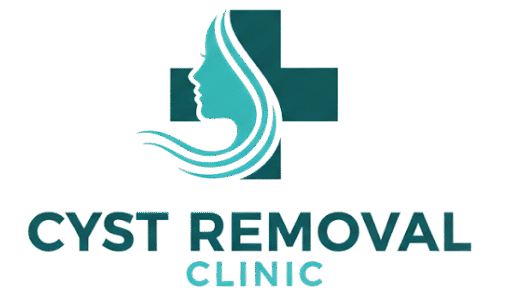Epidermoid cysts are one of the most frequently diagnosed skin lumps seen in private clinics across London. They are benign, slow-growing sacs that form beneath the skin when keratin, a natural protein that protects the skin, becomes trapped. Although harmless, these cysts can become inflamed, infected, or cause cosmetic concern if left untreated.
At Cyst Removal Clinic, our doctors specialise in epidermoid cyst removal using precise minor surgical methods under local anaesthetic. With short waiting times, same-day appointments and two central London locations, we offer safe, professional treatment with clear cosmetic outcomes.
What Is an Epidermoid Cyst?
An epidermoid cyst develops when skin cells move deeper than normal and multiply instead of shedding. These cells form the lining of the cyst, which slowly fills with soft keratin, a thick, white substance resembling cottage cheese.
They are sometimes incorrectly called “sebaceous cysts”, but the two are not the same. True sebaceous cysts originate from oil glands, whereas epidermoid cysts arise from the outer skin layer (epidermis). Both, however, appear as firm, round lumps beneath the skin and are treated in a similar way.
Epidermoid cysts can appear anywhere on the body, most commonly on the face, neck, chest, back, or shoulders. They can remain stable for months or gradually enlarge over time. While they are completely benign, they will not disappear on their own and may occasionally rupture.
Symptoms and Appearance
Typical features of an epidermoid cyst include:
- A round, dome-shaped lump under the skin
- Usually painless and slow-growing
- A central black dot or pore (the opening of the blocked follicle)
- Soft or firm texture; may move slightly under pressure
- Occasionally, a cheesy-white discharge if the cyst ruptures
When inflamed or infected, the cyst may become red, swollen and tender, sometimes producing pus or an unpleasant smell. Infection can occur spontaneously or after squeezing the cyst.
Epidermoid cysts differ from lipomas (fatty lumps) because they are closer to the surface and often have a visible pore. They also differ from abscesses, which are typically painful, hot, and filled with pus due to bacterial infection.
Causes and Risk Factors
Epidermoid cysts form when a hair follicle or oil gland becomes blocked, trapping keratin beneath the skin. They are most common in adults and can develop for several reasons:
- Blocked hair follicles after acne or skin irritation
- Minor skin injury allowing cells to enter deeper tissue
- Genetic predisposition (in rare cases such as Gardner’s syndrome)
- Hormonal influence during adulthood
- Skin friction or long-term irritation in certain areas
Although they can affect anyone, people with oily skin or a history of acne are slightly more prone to developing them.
Diagnosis and Medical Assessment
Most epidermoid cysts can be diagnosed by visual examination alone. During your consultation, the doctor will assess:
- The size, shape and location of the cyst
- Whether it is infected or inflamed
- Any previous cysts or scarring
- Suitability for same-day removal
In some cases, an ultrasound scan may be recommended to confirm the diagnosis or rule out deeper lesions. If the cyst looks unusual, for example, if it is rapidly enlarging or irregular in texture, your doctor may suggest histology testing after removal to confirm it is benign.
Treatment Options Available
Most epidermoid cysts are harmless and can remain untreated if they cause no pain, infection, or cosmetic concern. However, once a cyst becomes inflamed, painful, or continues to enlarge, professional treatment is recommended.
At Cyst Removal Clinic, our doctors offer two main options depending on your symptoms and the cyst’s location:
1. Conservative care – For smaller or mildly inflamed cysts, your doctor may suggest keeping the area clean, avoiding squeezing, and using short courses of prescribed antibiotics if infection is present. These steps may ease discomfort but will not permanently remove the cyst.
2. Surgical excision – The only definitive treatment is complete surgical removal of the cyst and its sac. This prevents regrowth and provides a long-term solution. The procedure is quick, performed under local anaesthetic, and leaves minimal scarring when carried out by an experienced doctor.
Epidermoid Cyst Removal Procedure
Cyst removal is a straightforward minor surgery that typically takes between 20–30 minutes. The steps are:
- The area is cleaned and numbed with local anaesthetic.
- A small incision is made over the cyst.
- The doctor removes the entire cyst sac and its contents carefully to prevent recurrence.
- The wound is closed with dissolvable or removable stitches and covered with a sterile dressing.
The procedure is performed on a walk-in, walk-out basis, meaning you can return home immediately afterwards. Our doctors prioritise cosmetic results, using fine suturing techniques to minimise visible scarring, especially for cysts on the face, neck, or scalp.
Recovery and Aftercare
Most patients recover quickly and return to normal activities the same or next day. Mild tenderness or swelling is common for a few days and can be managed with over-the-counter pain relief.
We advise keeping the wound clean and dry for the first 24 hours, avoiding strenuous activity until stitches are removed or fully dissolved. If your cyst was infected before removal, your doctor may prescribe antibiotics to aid healing.
A short follow-up appointment is often arranged to check healing and remove any stitches if needed. Once healed, the result is usually a flat, smooth area with minimal scarring.

